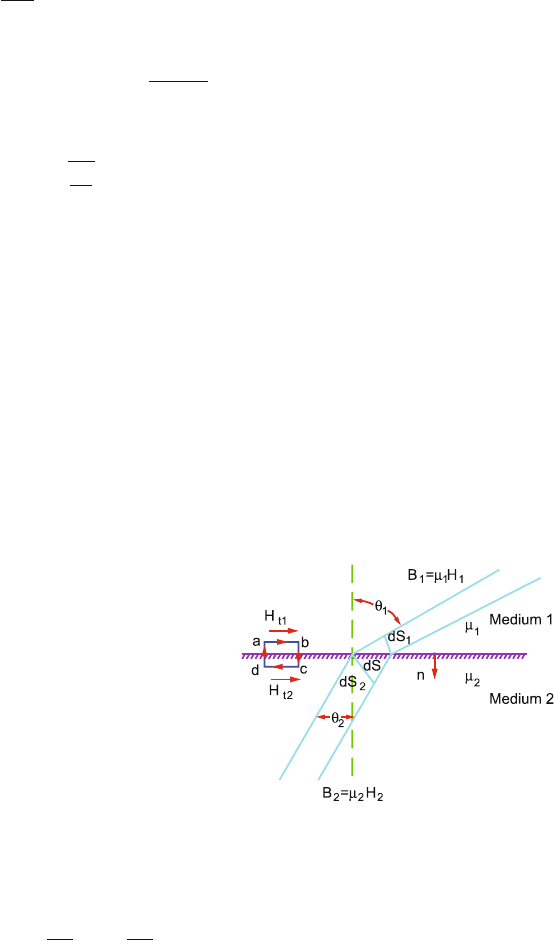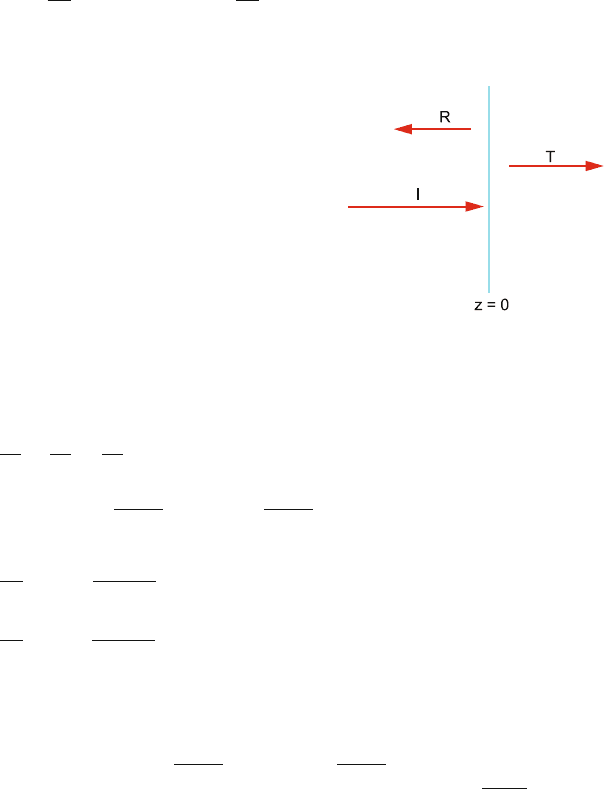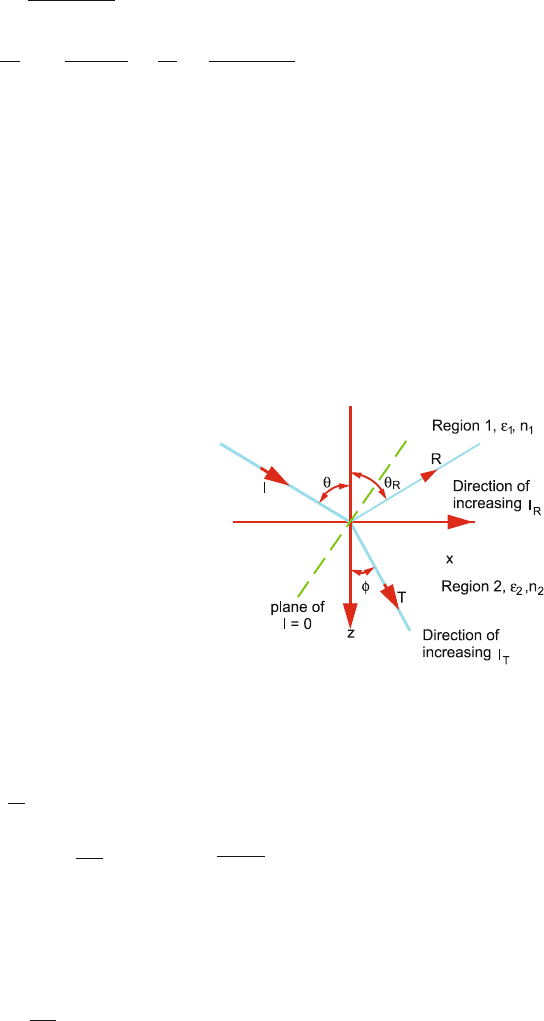Kamal A.A. 1000 Solved Problems in Classical Physics: An Exercise Book
Подождите немного. Документ загружается.


680 14 Electromagnetism II
Thus ∇×(∇×F) =−6x
2
z
ˆ
i +6xz
2
ˆ
k (1)
−∇
2
F +∇(∇·F) =−(6x
2
z + 2z
3
)
ˆ
i +2z
3
ˆ
i +6xz
2
ˆ
k
=−6x
2
z
ˆ
i +6xz
2
ˆ
k (4)
Comparing (1) and (4), the identity
∇×(∇×E) =−∇
2
E +∇(∇·E) is verified.
14.70 The electric field of the cable is radial and is given by
E = E
r
=
V
r ln(b/a)
(1)
where a and b are the radii of the inner and outer cable. The corresponding
magnetic intensity is tangential and is given by
H = H
φ
=
I
2πr
(2)
As the angle between E and H is 90
◦
, the Poynting vector
|
S
|
=
|
E × H
|
= EH (3)
So that S = S
z
=
VI
2πr
2
ln(b/a)
(4)
and the direction of S is that of the current in the positive conductor.
The power flow is confined to the space between the conductors and for any
plane perpendicular to the axis of the conductor
P =
b
a
S
z
2πrdr =
b
a
VI
ln(b/a)
dr
r
(5)
where we have substituted S
z
from (4).
But
b
a
dr
r
= ln(b/a) (6)
∴ P = VI (7)
This is the entire power transmitted by the cable. It follows that the Poynting
theorem indicates that the entire flow of energy resides in the space between
the conductors.

14.3 Solutions 681
If the resistance of the cable cannot be neglected then V is no longer constant.
An axial component of E is necessary to maintain the flow of current to
compensate for the Ohmic energy loss.
14.71 The current density in the wire is (I/πa
2
)ˆe
z
. Therefore the electric field in
the wire, including on the surface of the wire, will be (I/πa
2
σ
E
)ˆe
z
.
The magnetic field intensity by Ampere’s theorem is (I/2πa
2
)ˆe
φ
.
The Poynting vector at the s urface is given by
S = E ×H =
I
πa
2
σ
E
ˆe
z
×
I
2πa
ˆe
φ
=−
I
2
2π
2
a
3
σ
E
ˆe
r
(1)
Now Poynting’s theorem is
−
s
(E × H) · ds =
∂
∂t
V
ε
|
E
|
2
2
dV +
∂
∂t
V
μ
|
H
|
2
2
dV +
V
E · J dV (2)
Since the fields are constant in time, the first two terms on the right of (2)
which contain time derivative ∂/∂t vanish. The power dissipated in the wire
is then
P =
E ·JdV =−
(E ×H) · ds =−
I
2
2π
2
σ
E
a
3
(2πaL) =
I
2
L
πσ
E
a
2
= I
2
R
14.72
Given B =−
m
e
ne
2
∇ × J (1)
Use the vector identity
∇ × (∇ × B) =−∇
2
B +∇(∇ · B) (2)
Use Maxwell’s equations
∇ · B = 0(3)
∇ ×
B
μ
0
= J +ε
0
∂E
∂t
(4)
Here
∂D
∂t
= ε
0
∂E
∂t
= 0(5)
so that (4) becomes
∇ × B = μ
0
J (6)
Using (3) and (6) in (2)

682 14 Electromagnetism II
μ
0
∇ × J =−∇
2
B (7)
Using (1) in (7)
∇
2
B =
μ
0
ne
2
B
m
e
14.73 High-frequency resistance
R
s
=
ωμ
2σ
(1)
Direct current resistance per metre
R =
1
σ A
=
1
σπr
2
(2)
Further the skin thickness
δ =
2
μσ ω
(3)
For metals assume μ = μ
0
. Combining (1), (2) and (3)
R
s
R
=
πr
2
δ
μ
0
2
=
π(10
−3
)
2
6.6 × 10
−5
4π ×10
−7
2
= 3.77 ×10
−5
14.74 When a charge q moves in a magnetic field, it experiences a magnetic force
F
m
= qv × B (1)
When an electric conductor is physically moved across a magnetic field, the
free electrons in the conductor will experience a force on them in the direc-
tion of the force. The flow of electrons implies the existence of a potential
difference between the ends of the conductor. The situation is the same as if
an electric field had been set up in the conductor which is expressed by the
relation
E
m
= F
m
/q = v × B V/m(2)
Equation (2) implies that every moving magnetic field is accompanied by an
electric field.
From (2) and the definition of the emf ξ of a source, the instant emf of the
source is

14.3 Solutions 683
ξ =
E
m
· dl =
v × B ·dl V(3)
This is the general expression for motional emf. Now Faraday’s law states
that
E
m
· dl =−
dφ
dt
(4)
This equation states that every time-changing magnetic field has an electric
field associated with it. Now the total flux through the surface is
φ =
s
B ·ˆnds (5)
Therefore
dφ
dt
=
d
dt
B ·ˆn ds (6)
If the source and only the induction are changing, d/dt outside the integral
may be replaced by ∂/∂t inside the integral. The expression becomes
dφ
dt
=
∂B
∂t
·ˆn ds (7)
Combining (7) with (4)
c
E
m
· dl =−
∂B
∂t
·ˆn ds (8)
Transforming the line integral in (8) into surface integral by the use of
Stokes’ theorem
c
E · dl =−
s
ˆn · (∇ × E) ds (9)
Combining (8) and (9)
s
n · (∇ × E) ds =−
ˆn ·
∂B
∂t
ds (10)
Since this expression is true for any surface, the two integrals in (10) can be
equated to yield
∇ × E =−
∂B
∂t
(11)
This is known as Faraday’s law in point form or differential form.

684 14 Electromagnetism II
14.75 Ampere’s law is expressed by
B · dl = μ
0
i (1)
where B is known as magnetic induction or magnetic field. Its unit is weber
per metre square or tesla. If magnetic materials are placed in the field of
induction, the elementary magnetic dipoles, permanent or induced, will set
up its own field that will modify the original field. A large value of B in an
iron core is explained by a subsidiary vector, the magnetization M which is
the magnetic moment per unit volume of the core material. A hypothetical
current i
M
is introduced and Ampere’s law, (1), is modified accordingly:
B · dl = μ
0
(i + i
M
) (2)
Writing
B · dl = μ
0
i +μ
0
M · dl (3)
we find
B − μ
0
M
μ
0
· dl = i (4)
or
H · dl = i (5)
where H =
B −μ
0
M
μ
0
(6)
is known as the magnetic field strength.
∴ B = μ
0
(H + M) (7)
The unit of H is henry/metre.
(a) For paramagnetic material B is directly proportional to H, the relation
being B = k
m
μ
0
H, where k
m
is the permeability of the magnetic
medium, which is a constant for a given temperature and density of the
material.
(b) In ferromagnetic materials the relationship between B and H is far from
linear. The B–H curve is known as the familiar hysteresis curve. k
m
is a
function not only of the value of H but also because of hysteresis and is
a function of the magnetic and thermal history of the specimen.
14.76 Consider Maxwell’s equations
∇ · E = ρ/ε (1)

14.3 Solutions 685
and ∇ × H = J +
∂D
∂t
(2)
Define a new electric potential function φ(r, t) such that
E =−∇φ −
∂A
∂t
(3)
The reason for redefining the scalar potential in this fashion is that (3) is
consistent with Faraday’s law, ∇ × E =−
(
∂B/∂t
)
, as can be verified by
substitution. On the other hand the electrostatic definition, E =−∇V is
inconsistent with Faraday’s law and therefore cannot be used in electrody-
namics. However, the relation B = ∇ × A, continues to be correct. Substi-
tuting (3) in (1), we obtain
∇
2
φ +
∂
∂t
(
∇ · A
)
=−
ρ
ε
(4)
Substituting B = ∇ × A in (2), we get
∇
2
A − ∇(∇ · A) =−μJ −με
∂E
∂t
(5)
It is convenient to choose a Lorentz gauge given by
∇ · A =−
1
c
2
∂ϕ
∂t
(Lorentz condition) (6)
With the use of (6), (4) and (5) are simplified to
∇
2
ϕ −
1
c
2
∂
2
ϕ
∂t
2
=−
ρ
ε
(7)
∇
2
A −
1
c
2
∂
2
A
∂t
2
=−μJ (8)
14.77
∇ × E =−
∂B
∂t
(Faraday’s law) (1)
Writing the curl in rectangular form gives
∂ E
y
∂z
=−
∂ B
x
∂t
Integrating in time and choosing the constant of integration as zero, we
obtain
B
x
=
1
v
f (z − vt) (2)

686 14 Electromagnetism II
Notice that the variation of B is exactly the same as the variation of E, except
that E
y
and B
x
are at right angles to each other and perpendicular to the
direction of propagation. From (2) and the relation H
x
= B
x
/μ
0
we find
H
x
=
1
μ
0
v
f (x −vt) (3)
so that E
y
= μ
0
v H
x
(4)
Using the relation v =
√
1/μ
0
ε
0
, we can write (4) in the form
E
y
= Z
0
H
x
with Z
0
=
μ
0
ε
0
= 376.6 .
14.78
(a) E(z, t) = E
0
[ˆx sin(kz − ωt) +ˆy cos(kz − ωt)]. This is a plane polar-
ized wave polarized in the xy-plane and propagating in the positive
z-direction.
(b) The magnetic lines will suffer refraction in passing from one magnetic
medium to another.
(i) The continuity of B lines is first specified as a necessary condi-
tion. Figure 14.8 shows a bundle of B lines in passing through the
interface between two magnetic media characterized by μ
1
and μ
2
.
(ii) Since div B = 0, it is required that the magnetic flux associated
with the flux lines be constant in passing through the interface.
φ = B
1
ds
1
= B
2
ds
2
Fig. 14.8 The refraction of
magnetic lines
where ds
1
and ds
2
are the cross-section of the flux lines in medium
1 and 2, respectively. Dividing by ds, the corresponding area on the
interface, we get
B
1
ds
1
ds
= B
2
ds
2
ds

14.3 Solutions 687
which from Fig. 14.8 may be written as
B
1
cos θ
1
= B
2
cos θ
2
(1)
which may be written as
B
1
·ˆn = B
2
·ˆn
which shows that the normal component of the B vector is the same
on both sides of the boundary.
(iii) Next we apply Ampere’s circuital law to the path across the inter-
face, Fig. 14.8. Assuming that no current exists in the interface, for
the path considered
H · dl = 0
Breaking the integral into individual parts of the path
H · dl =
b
a
H · dl +
c
b
H · dl +
d
c
H · dl +
a
d
H · dl = 0
In the limit the path shrinks approaching the interface
c
b
H · dl =
a
d
H · dl = 0
∴
b
a
H · dl +
d
c
H · dl = 0
Thus H
t1
= H
t2
i.e. H
1
׈n = H
2
׈n (2)
This implies that the tangential component of the H vector is the
same on both sides of the boundary.
(c) Dividing (2) by (1)
H
1
sin θ
1
B
1
cos θ
2
=
H
2
sin θ
2
B
2
cos θ
2
∴
1
μ
1
tan θ
1
=
1
μ
2
tan θ
2
∴
tan θ
1
tan θ
2
=
μ
1
μ
2
(law of refraction)

688 14 Electromagnetism II
14.79 Consider a plane wave normally incident on a dielectric discontinuity, as in
Fig. 14.9. In the region z < 0, ε = ε
1
, and for z > 0, ε = ε
2
. The boundary
condition on E is that its tangential component is continuous, the boundary
condition on H is that its tangential component is also continuous.
E
i
(z = 0) + E
r
(z = 0) = E
t
(z = 0) (1)
H
i
(z = 0) + H
r
(z = 0) = H
t
(z = 0)
Letting E
i
= E
0
e
−jkz
e
x
, E
r
= E
1
e
jkz
e
x
, E
t
= E
2
e
−jkz
e
x
,
H
i
=
E
0
η
e
−jkz
e
y
and H
r
=−
E
1
η
e
−jkz
e
y
(2)
Fig. 14.9 Reflection of plane
waves normally incident on
the interface between two
dielectrics
and substituting in (1), we obtain
E
0
+ E
1
= E
2
(3)
E
0
η
1
−
E
1
η
1
=
E
2
η
2
(4)
where η
1
=
√
μ
1
/ε
1
and η
2
=
√
μ
2
/ε
2
. Solving, we find
E
1
E
0
= ρ =
η
2
− η
1
η
2
+ η
1
(5)
E
2
E
0
= τ =
2η
2
η
2
+ η
1
(6)
Note the minus sign in the last relation for H
r
in (2) arises because the Poynt-
ing vector S = E × H must be in the direction of propagation (right-hand
rule).
Substituting η
1
=
√
μ
1
/ε
1
and η
2
=
√
μ
2
/ε
2
in (5) and (6) and setting
μ
1
= μ
2
= μ
0
for non-magnetic substances, and putting
√
ε
1
/ε
2
= n
1
/n
2
for the refractive index, we obtain

14.3 Solutions 689
R = ρ
2
=
(
n
2
− n
1
)
2
(
n
2
+ n
1
)
2
(7)
T = τ
2
n
1
n
2
=
2n
2
n
2
+ n
1
2
n
1
n
2
=
4n
1
n
2
(n
1
+ n
2
)
2
(8)
Adding (7) and (8) it follows that R +T = 1. This is simply the consequence
of conservation of energy.
14.80 Refer to Fig. 14.10. Consider a plane perpendicular to the propagation direc-
tion through the origin. Let the distance from this plane measured in the
direction of propagation be called l. If the coordinates of a point are x, z,
then
l
I
= x sin θ + z cos θ (1)
Fig. 14.10 Reflection and
Refraction of electromagnetic
wave
As the electric field is in the plane of incidence, for the incident wave
=
E
I
= E
0
e
jk
I
l
I
(cos θ e
x
− sin e
z
)
H
I
=
E
0
η
1
e
−jk
I
l
I
e
y
(2)
where k
1
= ω
√
νε
1
and η
1
=
√
μ
1
/ε
1
are the values of the propagation
constant and characteristic impedance in region 1.
For the reflected wave l
R
= x sin θ
− z cos θ
(3)
⎧
⎨
⎩
E
R
= E
R
e
−jk
I
l
R
(cos θ
R
e
x
+ sin θ
R
e
z
)
H
R
=−
E
R
η
1
e
−jk
I
l
R
e
y
(4)
